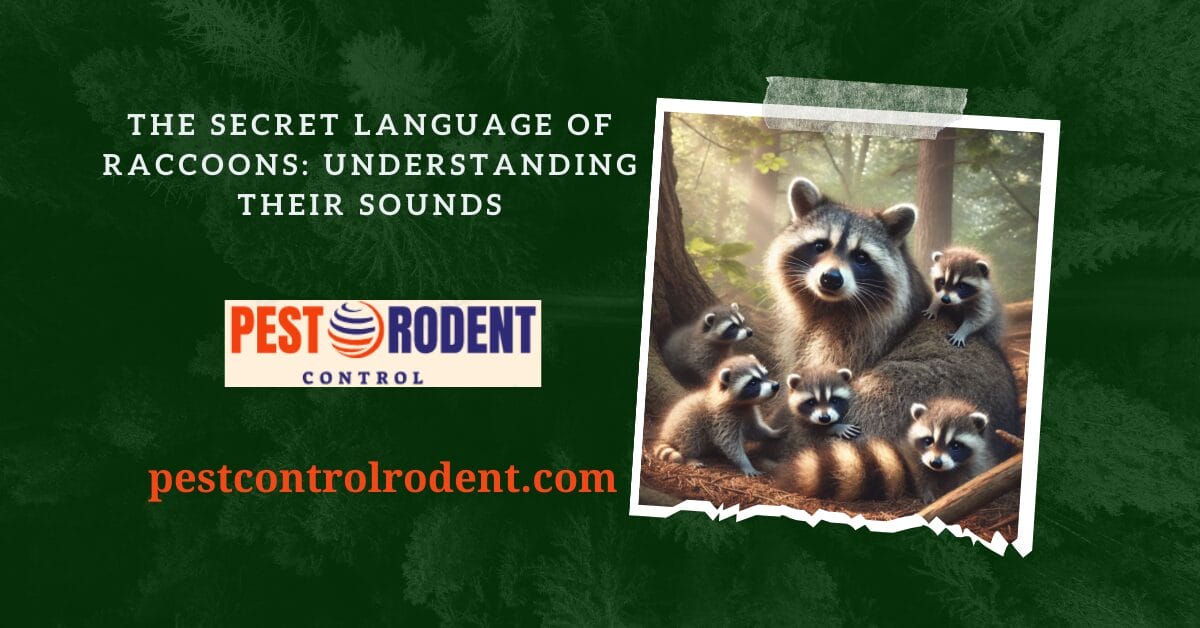The Secret Language of Raccoons: Understanding Their Sounds

The Secret Language of Raccoons: Understanding Their Sounds
Introduction
Raccoons are fascinating creatures not only capture our attention with their playful antics but also communicate in ways that can seem quite complex. Understanding the sounds they make can give us valuable insights into their behavior, social structures, and even their survival strategies. By studying raccoon sounds, we can foster a deeper appreciation for these nocturnal bandits and potentially aid in their conservation. This article aims to decode the secret language of raccoons and help you recognize the various sounds they make.

1. The Basics of Raccoon Sounds
1.1 What Sounds Do Raccoons Make?
Raccoons are known for a variety of vocalizations, each serving a unique purpose. Some of the most common sounds include:
- Growls: Often a sign of aggression or discomfort, growls can be heard when raccoons feel threatened.
- Chirps: These are softer, quicker sounds that are often associated with friendly communication, especially among family members.
- Whines: Whining can indicate distress or a desire for attention, particularly when young raccoons call out to their mothers.
Raccoons vocalize throughout the day, but they are especially active at night. Depending on the time of year—such as during mating season—you might hear them making more sounds, perhaps due to increased interaction.
1.2 Anatomy of Raccoon Vocalization
Raccoons have surprisingly versatile vocal cords that can produce a wide range of sounds. Their physical structure allows them to manipulate air and create different pitches. Additionally, raccoons use facial expressions and body language to enhance their vocal communication.
When compared to other mammals, raccoon vocalizations are quite unique. While dogs might bark and cats may meow, raccoons utilize a more varied array of sounds, allowing them to express a broader range of emotions.
1.3 Interpretations of Raccoon Sounds
Understanding raccoon sounds goes deeper than just recognizing them. The meaning behind these vocalizations can vary significantly based on context. For example, a chirp can indicate excitement when raccoons encounter each other, while a growl might signal a warning.
Culturally, different perspectives on raccoon sounds can also emerge. Some people see raccoons as mischievous troublemakers, interpreting sounds through that lens, while others may view them as misunderstood creatures communicating in their own intricate language.

2. Types of Vocalizations
2.1 Communication Sounds
Raccoons have developed a range of sounds specifically for social interaction. These vocalizations play a critical role in mating and parenting behaviors.
- Screams: These loud calls can serve to attract a mate or signal distress.
- Whines: Used often in younger raccoons, whines can ask for food or care from mothers.
- Barks: Short barks can indicate a raccoon is alerting group members to an approaching threat.
2.2 Warning Sounds
Raccoons are clever animals, equipped with a sound repertoire to indicate danger.
- Growls and hisses often accompany facial cues when a raccoon feels threatened.
- The behavioral response is typically defensive; they may puff up or prepare to flee.
Situations triggering these warning sounds could include encounters with predators or confrontations with other raccoons.
2.3 Agonistic and Territorial Sounds
Sounds related to aggression and territorial claims are also significant within raccoon communication.
Aggressive vocalizations may signify competition for resources or space. For instance, a raccoon may growl or snarl during confrontations with another during mating season or while fighting for food. These sounds send a clear message: “This is my space!”
3. The Role of Sound in Raccoon Behavior
3.1 Social Structure and Group Dynamics
Sounds play an essential role in maintaining group dynamics among raccoons. Vocalizations help reinforce social bonds, particularly within family units.
When they are together, family raccoons will often engage in soft chirps or whines, reinforcing their sense of unity. In larger groups, vocal sounds may differentiate social roles, impacting hierarchy.
3.2 Sounds and Mating Rituals
During mating season, raccoons amplify their vocalization efforts. Specific calls become prominent, often signaling availability or attraction.
Vocalizations can influence mate selection; males may use certain sounds to impress females. Courting behaviors often involve intriguing calls, with a lot of communication from both sexes aiding in the pairing process.
3.3 Sounds in Parenting
Mother raccoons communicate intimately with their young through soft vocalizations, helping to bond and guide them.
From the moment kits are born, mothers will use gentle sounds to reassure them and provide care. As the kits grow, their own vocal skills develop—each stage marked by unique sounds as they learn from their environment.
4. Environmental Influences on Raccoon Sounds
4.1 Habitat and Sound Variation
Raccoons are adaptable creatures, and their vocalizations can vary significantly based on the environment in which they live.
- Raccoons in urban areas may develop different sound patterns compared to those in rural settings, influenced by nearby noise levels.
- For instance, urban raccoons might make more sounds when competing for food resources in noisier environments.
4.2 Seasonal Changes in Vocalizations
Throughout the year, you may notice changes in raccoon vocalizations. During breeding season, the sounds may become more pronounced.
Seasonal changes, such as temperature or food availability, can also influence vocal production, leading to variations in sound signaling among raccoons.
4.3 Response to Human Presence
Raccoons often modify their sounds based on human activity. In communities where interactions are common, raccoons may adapt their vocalizations to communicate more effectively with one another amid the chaos.
By observing these adaptations, we can gain insights into human-wildlife interactions and how they affect raccoon behavior.
5. Observing Raccoon Sounds in the Wild
5.1 How to Identify Raccoon Sounds
If you’re interested in recognizing distinct raccoon vocalizations, pay attention to the time of day—most activity occurs at night.
Using your ears, you can begin to distinguish between the various sounds with practice. Helpful tools such as wildlife identification guides and sound apps can enhance your learning.
5.2 Documenting Raccoon Sounds
Recording sounds can be an enjoyable and educational experience. Consider using a smartphone or microphone to capture vocalizations for future analysis.
Technology makes it easier than ever to document wildlife sounds. Active observation can lead to fascinating discoveries, so ensure you respect the animals’ space while studying them.
5.3 Community Engagement and Citizen Science
There are many opportunities for community involvement in monitoring raccoon populations. Engaging in citizen science projects can amplify our understanding of raccoon behavior, including their vocalizations.
Public awareness is key in the conservation effort, so educating others about the importance of raccoon sounds can encourage respect and care for these creatures.
Conclusion
By unraveling the secret language of raccoons through their sounds, we gain valuable insights into their behavior, social structure, and needs. Understanding these captivating creatures can lead to better conservation efforts and a deeper appreciation for wildlife around us. Next time you hear the gentle chirp or a sudden growl, remember there’s a whole world of communication happening right outside your window.
FAQs
What does it mean if a raccoon is making a lot of noise?A raccoon making excessive noise may be experiencing distress, signaling a threat, or attempting to communicate with others.
Are raccoon sounds seasonal?Yes, raccoon sounds can vary through the seasons, particularly during mating season when vocalizations tend to increase.
How can I help raccoons if I hear them in my neighborhood? Being mindful of your environment can help! Secure your trash and avoid attracting raccoons unnecessarily. If they seem to be in distress or conflict, consider contacting local wildlife agencies for assistance.






